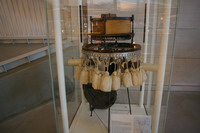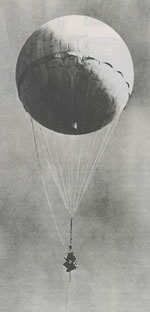
Interesting Historical Bit
A guest post by Rancino. I helped a little. I tell ya, I’m gonna hafta hire that boy one of these days! ![]()
UPDATE: Reader Tony has actually seen one of these things and sent me a pic. OUTSTANDING !!! Click the thumbnail for a much bigger picture. Tony, you are awesome!!

During World War II, Japan had a secret weapon designed to spark a massive forest fire in the United States. Thanksfully, the device - which was partly made by Japanese schoolgirls - was a dud. Here’s the bizarre story of the Fugo killer balloons:

On May 5, 1945, Reverend Archie Mitchell, his wife Elsie, and five children from his Sunday school drove from the tiny southern Oregon town of Bly for a picnic on Gearhart Mountain. While Reverend Mitchell parked the car, his wife and the children explore. They came upon a device the U.S. government knew about but had kept secret. When one of them touched the device, it exploded: Mrs. Mitchell and the five children were killed. The six Oregonians became the only known fatalities on the U.S. mainland from enemy attack during all of World War II.
MADE IN JAPAN
The exploding contraption was a Japanese Fugo balloon bomb, the brainchild of Major General Sueyoshi Kusaba of the Japanese Ninth Army Technical Research Laboratory. The balloons measured 33 feet across and 70 feet long from top to bomb. They were constructed (by Japanese schoolgirls) from bits of a tough paper called washi, made from mulberry trees, and glued together with potato paste. The bomb parts were made in a factory - not by schoolgirls.
Filled with hydrogen gas, the payload consisted of 36 sandbags for ballast, four incendiary bombs, and one 33-pound antipersonnel bomb. Launched to rise 35,000 feet, the balloons were designed to use the prevailing Pacific eastward winds to reach the west coast of North America. As the balloons leaked gas and lost altitude, barometric pressure switches caused the sandbags to drop off and the balloons to rise back to the jetstream. The trip took three to five days. By the time they reached the United States, the baloons, now out of sandbags, were supposed to drop the bombs and then self-destruct. The Japanese hoped the bomb would cause forest fires and panic the American public.
FUGO, FUGO, FUGO!
Between October 1944 and April 1945, Japan launched 9,300 of these balloons. Estimates are that fewer than 500 balloons reached the United States or Canada; the rest fell into the Pacific Ocean.
The first discovery of a balloon in North America was made by two woodchoppers, who discovered a balloon on the ground near Kalispell, Montana in December, 1944. After it was determined that the balloon originated in Japan, tight censorship was imposed on further balloon sightings, since it was feared that disclosing when and where balloons were being found would encourage the enemy to launch more balloons and perfect their delivery. It was also thought that the balloons posed little danger to the public at large, so even though some government and military officials and newspapermen knew about the bombing balloons early on, the general public was not told about them until May of 1945, about six months after they were first launched.
In November 1944, one balloon was discovered in the ocean off San Pedro, California. In January 1945, a balloon bomb landed in Medford, Oregon, without exploding. At some point, a rancher in Nevada discovered a balloon and used it as a tarp to cover his hay; police later discovered that two bombs were still attached to it.
WHAT BALLOONS?
Most of the balloons either exploded harmlessly or failed to detonate on impact. Approximately 90 of them were recovered in the United States as far east as Michigan. Strict censorship kept their existence out of the newspapers, and those who knew of their presence were sworn to secrecy. It was feared that news of the balloons arrival would encourage the launching of more balloons. They weren’t seen as much of a danger, but the hush-hush handling of the situation worked: the Japanese abandoned the project because they didn’t hear of any success.
But after the Mitchell family tragedy in Oregon, the public was warned. The last balloon bomb was found in Alaska in 1955; its bombs were still capable of exploding. Ironically, on March 10, 1945, one of the last paper balloons descended near Hanford, Washington. The balloon landed on electrical power lines, shutting off the Hanford nuclear reactor for three days. The Hanford reactor, part of the top-secret Manhattan project, was producing plutonium for the bomb that was dropped on Nagasaki, Japan, five months later.
The Fugo balloon bombs are considered a failure as weapons system. There were no proven bomb-caused forest fires, and they caused little other damage. Elsie Mitchell and the five children were the tragic exceptions.
On the West Coast of the US a secret mission was being done protect the country from the Fugos. It was called “Fire Fly” and included aircraft, to shoot down the balloons and a troop of fire fighters to put out the fires. These “Smoke Jumpers” were the first to jump to a forest fire and fight them the way we do today. They were called the “Triple Nickle” for the 555 designation their battalion was given. Here is their web site.

Many of the balloons had been made by patriotic Japanese school children as a part of the war effort. In 1987, several tried to atone. They folded 1,000 paper cranes, a Japanese symbol of healing and peace, and sent them to the families of the Oregon picnickers. Here is an excerpt from one of the accompanying letters:
“We participated in the building of weapons used to kill people without understanding much beyond the knowledge that America was our adversary in a war. To think that the weapons we made took your lives as you were out on a picnic! We were overwhelmed with deep sorrow.”
While I don’t feel guilty for the acts committed by the U.S. during the war, I must admire the honesty, the decency and contrition of these women. I really don’t understand why they fell guilt, but they impress me regardless.
Posted by Dr. Jeff 09/11/2008 at 04:46 AM
09/11/2008 at 04:46 AM

War, by its nature, is a series of organized atrocities. They did for their country what any citizen working in the armaments industry would do. I suppose that because I hold that belief, their feeling of guilt and their acts of contrition convince me of their deep humanity.
Posted by Dr. Jeff 09/11/2008 at 05:10 AM
09/11/2008 at 05:10 AM

That is a whole lot farther up the evolutionary scale then the raghead parties after sept 11.
Posted by Chris Edwards 09/11/2008 at 12:25 PM
Commenting is not available in this weblog entry.
09/11/2008 at 12:25 PM
Commenting is not available in this weblog entry.
Next entry: A Selection of Political Graphics
Previous entry: If You Can't Take The Heat